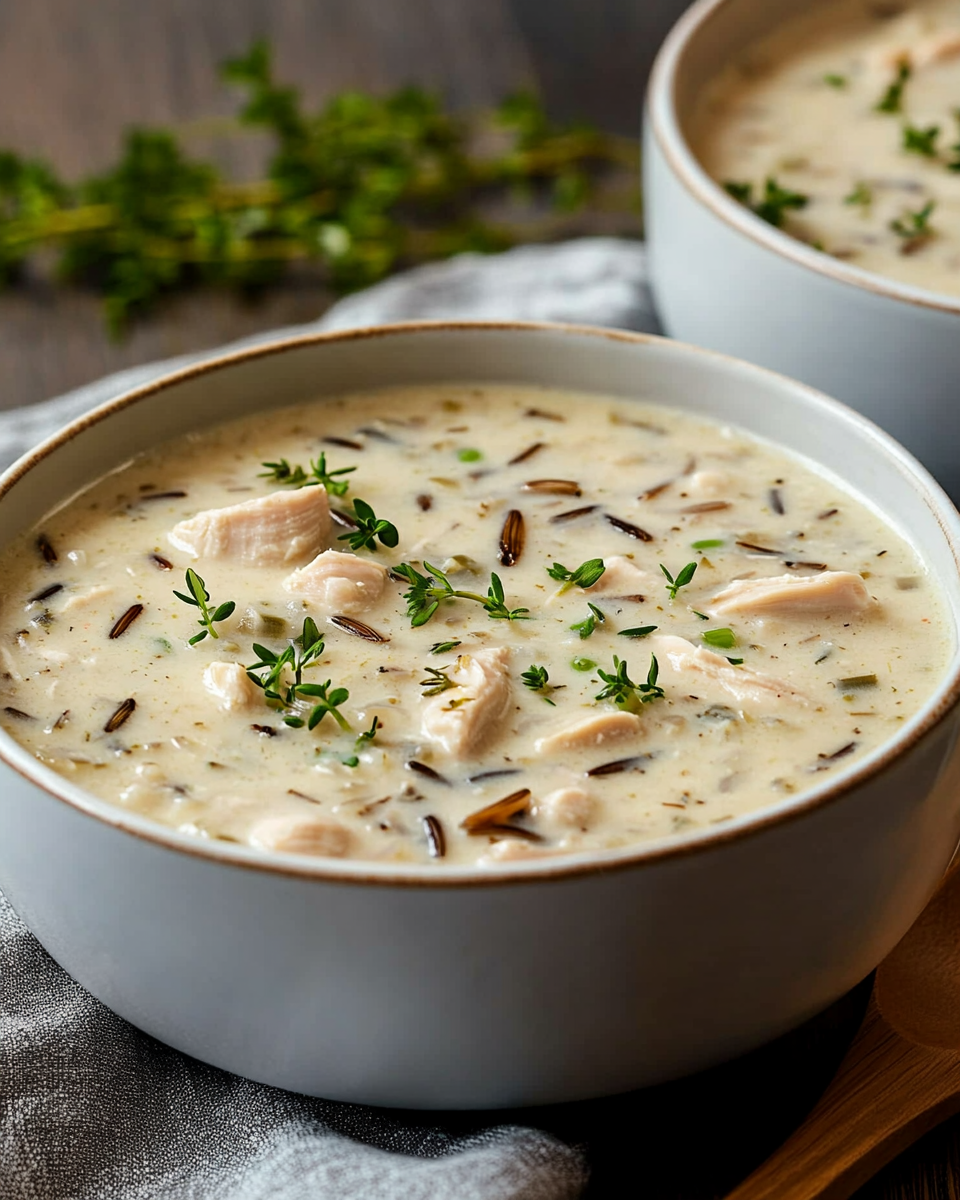This Creamy Chicken and Wild Rice Soup is the ultimate comfort food—rich, hearty, and full of flavor. It combines tender chunks of chicken, earthy wild rice, and a creamy broth seasoned with herbs and vegetables. Perfect for a cozy dinner or a warming lunch on a chilly day.
FULL RECIPE
Ingredients
- 1 lb boneless, skinless chicken breasts (or thighs)
- 1 cup uncooked wild rice blend
- 1 tablespoon olive oil
- 1 small onion, chopped
- 2 cloves garlic, minced
- 3 carrots, diced
- 3 celery stalks, diced
- 8 cups low-sodium chicken broth
- 1 teaspoon dried thyme
- 1 teaspoon dried rosemary
- 1 bay leaf
- Salt and pepper, to taste
- 4 tablespoons unsalted butter
- 1/3 cup all-purpose flour
- 2 cups whole milk or half-and-half
- Optional: fresh parsley for garnish
Directions
- In a large pot or Dutch oven, heat olive oil over medium heat. Add onion, garlic, carrots, and celery. Sauté for 5–6 minutes until softened.
- Add chicken breasts, wild rice, chicken broth, thyme, rosemary, bay leaf, salt, and pepper. Bring to a boil.
- Reduce heat to low, cover, and simmer for 45–50 minutes, or until rice is tender and chicken is cooked through.
- Remove chicken from the pot, shred with two forks, and return to the soup.
- In a separate saucepan, melt butter over medium heat. Whisk in flour and cook for 1–2 minutes to form a roux.
- Slowly whisk in the milk, stirring constantly until thickened (about 5–6 minutes).
- Add the creamy mixture to the soup pot and stir to combine.
- Let the soup simmer for another 5–10 minutes until fully blended and creamy. Adjust seasoning if needed.
- Serve hot, garnished with fresh parsley if desired.
Nutritional Information
- Calories: 360 per serving
- Protein: 26g
- Fat: 16g
- Saturated Fat: 8g
- Carbohydrates: 28g
- Fiber: 3g
- Sugar: 5g
- Cholesterol: 80mg
- Sodium: 560mg
- Potassium: 550mg
History and Origins of Chicken and Wild Rice Soup
Chicken and wild rice soup has roots in North American cuisine, particularly influenced by Indigenous peoples of the Great Lakes region who harvested wild rice long before European settlers arrived. This soup blends the hearty, nutty flavor of wild rice with the comforting, familiar taste of chicken broth, creating a dish that is both rustic and refined. Over time, it has evolved into a popular comfort food in many American households, especially during the colder months. Its combination of wholesome ingredients makes it a nutritious and satisfying meal that reflects a rich cultural heritage.
Nutritional Benefits of Wild Rice
Wild rice is not actually rice but a type of aquatic grass seed that is rich in protein, fiber, and essential minerals such as magnesium, zinc, and phosphorus. Compared to regular white rice, wild rice provides more antioxidants and is lower in calories and carbohydrates. Its high fiber content supports digestive health and helps maintain steady blood sugar levels. Including wild rice in this soup boosts its nutritional value, making it a great choice for those looking to eat a balanced diet without sacrificing flavor or heartiness.
Why Use Bone-In vs. Boneless Chicken
The recipe typically calls for boneless chicken breasts or thighs for convenience and ease of shredding. However, using bone-in chicken can deepen the flavor of the broth, adding a richer, more complex taste due to the collagen and marrow released during cooking. While boneless cuts speed up prep and make the soup easier to eat, bone-in options require longer simmering but result in a more robust soup base, enhancing both texture and nutrition with added minerals from the bones.
The Role of the Roux in Creamy Soups
A roux is a mixture of fat (butter) and flour cooked together to thicken soups and sauces. In creamy chicken and wild rice soup, the roux is essential for creating that smooth, velvety texture. It allows the milk or cream added later to bind with the broth, preventing separation and giving the soup a luscious mouthfeel. Mastering the roux technique is key to achieving a perfect balance between creaminess and the natural flavors of the ingredients without the soup becoming too heavy or clumpy.
Herbs and Seasonings that Elevate the Flavor
Thyme, rosemary, and bay leaf are classic herbs that bring warmth and earthiness to the soup. Thyme adds a subtle floral note, rosemary contributes a pine-like fragrance, and the bay leaf lends a gentle bitterness that rounds out the taste profile. These herbs complement the mild flavor of chicken and the nutty character of wild rice, making the soup fragrant and well-rounded. Fresh herbs can be used as garnish to brighten the dish and add a pop of color.
How to Make the Soup Gluten-Free
For those with gluten sensitivities or celiac disease, the flour in the roux can be substituted with gluten-free alternatives such as cornstarch, arrowroot powder, or a gluten-free flour blend. These thickeners work similarly to traditional flour when carefully whisked into the butter and milk mixture. Adjustments in quantity and cooking time may be necessary to achieve the same creamy consistency. This flexibility makes chicken and wild rice soup accessible to a wider range of dietary needs without compromising taste or texture.
Tips for Cooking Wild Rice Perfectly
Wild rice requires longer cooking times than white rice due to its tougher outer shell. Rinsing the rice before cooking removes excess starch and impurities. To ensure it cooks evenly, simmer it gently in the broth rather than boiling rapidly, which can make the grains tough or uneven. Wild rice should be tender but still slightly chewy, offering a pleasant bite that contrasts well with the soft chicken and creamy broth. Leftover cooked wild rice can be refrigerated or frozen, making it convenient for quick meal prep.
Variations to Customize the Soup
This soup is versatile and lends itself well to many variations. You can add mushrooms for an earthy depth, swap cream for coconut milk for a dairy-free version, or incorporate vegetables like peas, corn, or spinach to boost nutrition and color. For a spicy twist, add a pinch of cayenne or smoked paprika. Those wanting a heartier meal can include potatoes or substitute turkey for chicken. These modifications allow home cooks to tailor the soup to personal preferences or dietary restrictions while keeping the comforting essence intact.
Serving Suggestions and Pairings
Creamy chicken and wild rice soup pairs beautifully with crusty bread, garlic toast, or a fresh green salad to balance the richness. It can be served as a starter or a main dish depending on portion size. For a complete meal, consider adding a light appetizer or a simple dessert like fruit or sorbet. The soup also freezes well, making it an ideal option for meal planning or batch cooking, allowing you to enjoy a homemade comfort meal anytime with minimal effort.
Storage and Reheating Tips
Proper storage is key to maintaining the soup’s flavor and texture. Keep it in airtight containers in the refrigerator for up to 3-4 days or freeze it for up to 3 months. When reheating, do so gently on the stove over low heat, stirring occasionally to prevent the dairy from separating. If the soup thickens too much after cooling, add a splash of broth or milk to restore its creamy consistency. Avoid microwaving at high heat to preserve the smooth texture and prevent curdling.
Health Considerations and Dietary Adaptations
While this soup is hearty and comforting, it can be adjusted to fit various health goals. Using low-fat dairy or plant-based milk alternatives reduces calories and saturated fat. Reducing or omitting added salt helps manage sodium intake. For a protein boost, add beans or extra chicken. The fiber-rich wild rice supports digestive health and sustained energy. Overall, it’s a nourishing meal that can be easily customized to meet specific dietary needs such as low-carb, gluten-free, or dairy-free diets.
Conclusion
Creamy chicken and wild rice soup is a timeless dish that combines nutrition, flavor, and comfort in one bowl. Its roots in traditional North American cuisine give it a rich cultural background, while its versatile ingredients and preparation methods make it a favorite for many. Whether enjoyed as a warming lunch or a satisfying dinner, this soup offers endless possibilities for customization and health-conscious adaptations. With its creamy texture, wholesome ingredients, and aromatic herbs, it truly embodies the essence of home-cooked comfort food.






